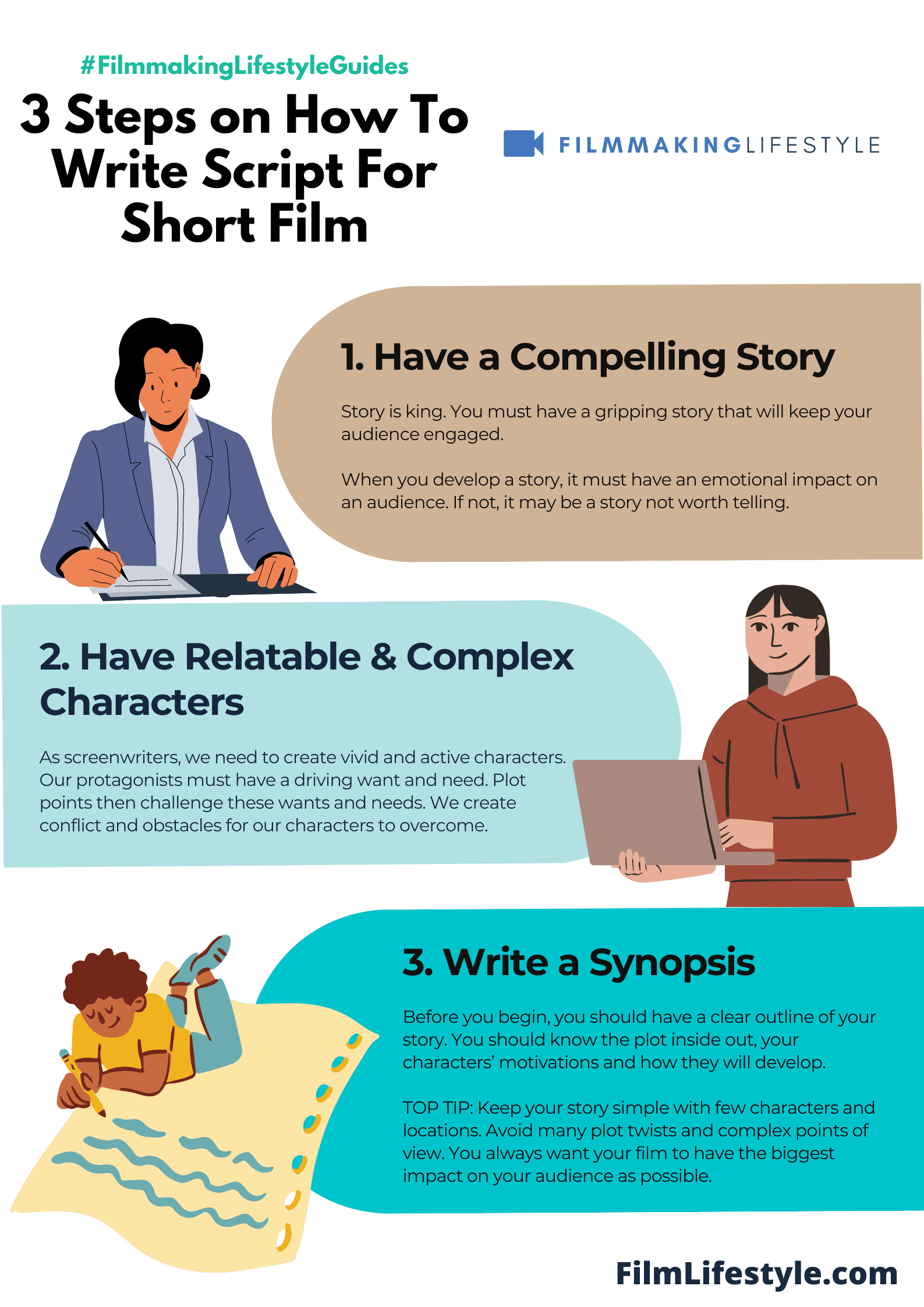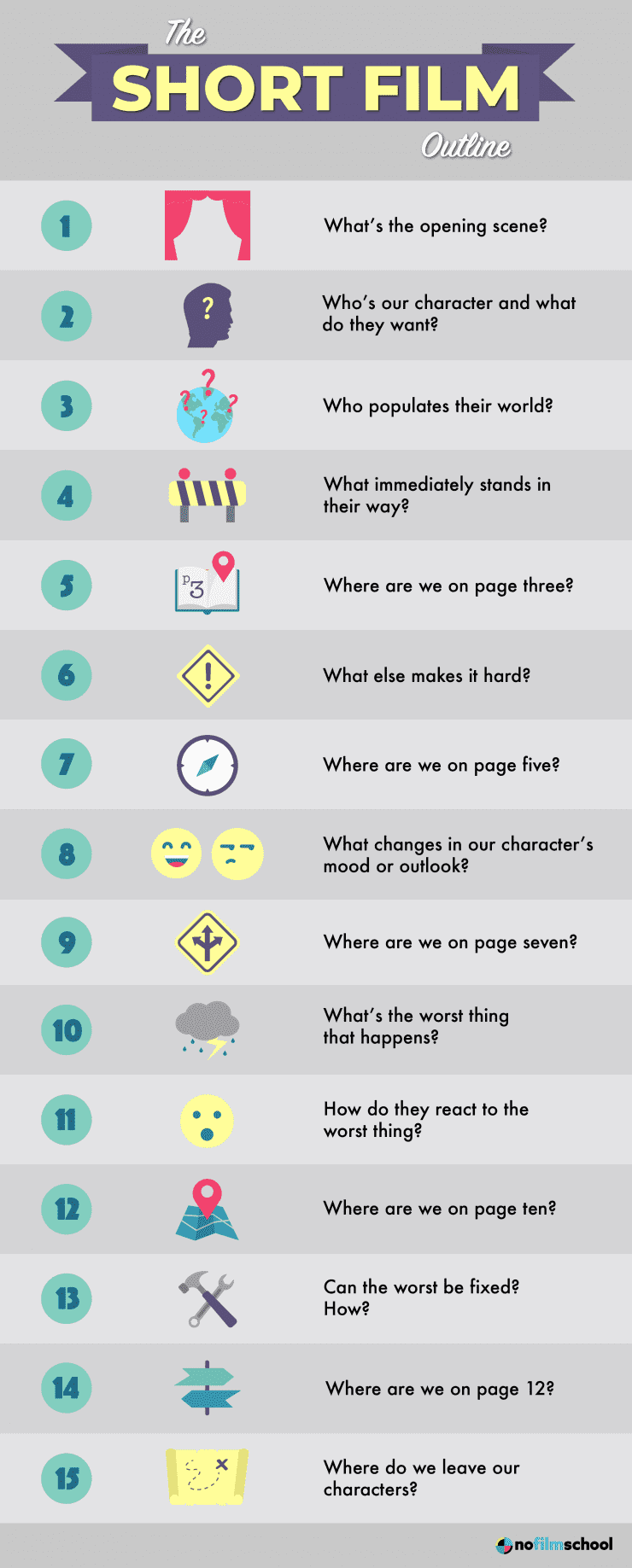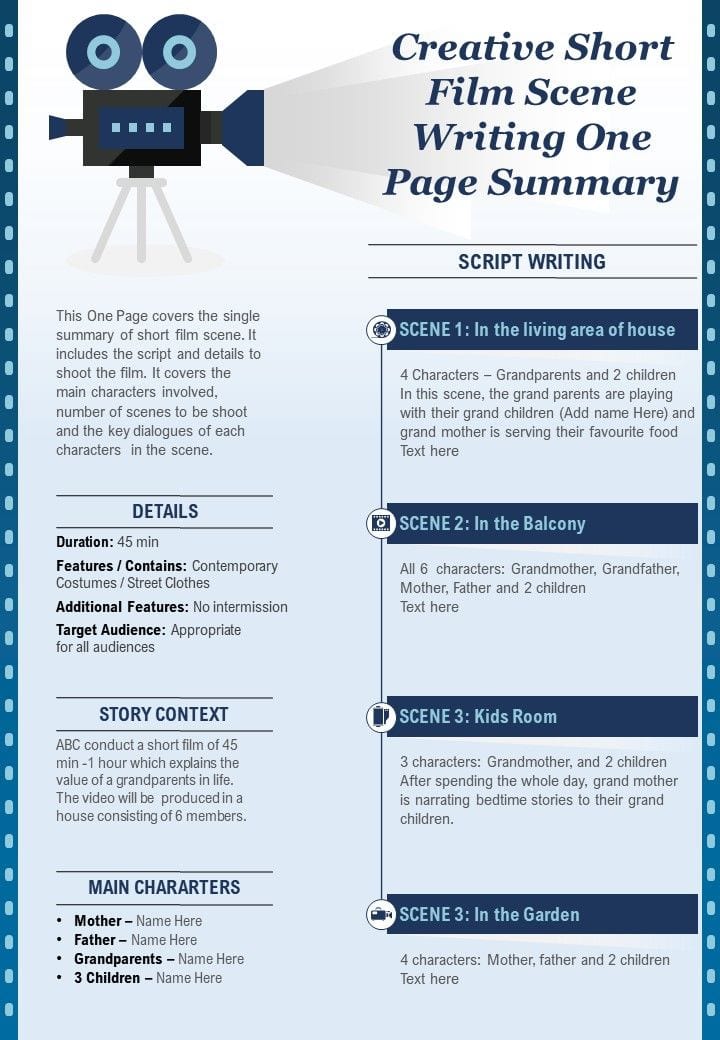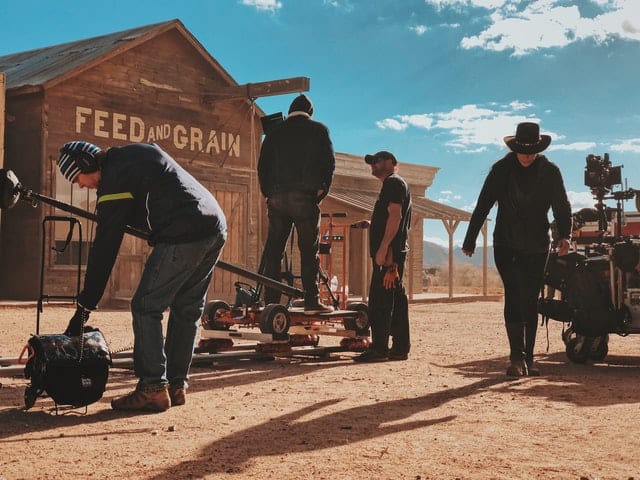The word “short” in the title of this post could have a few meanings. The first is that it’s simply not long; the second meaning is that there are only two things to know about short films, and finally, you can watch them quickly!
The term “short film” typically refers to a motion picture that has been created for either artistic or commercial purposes. They’re often less than 60 minutes long, although some are much shorter (under 20 minutes).
Short films may be used as an art form to explore ideas creatively or they might be designed solely with commercial considerations in mind.
There are many genres, but the most common type of short film is comedy/satire, followed by drama.
HOW TO WRITE SCRIPT FOR SHORT FILM
What Is a Script For a Short Film?
A script for a short film is a written document that outlines all of the scenes and dialogue that will be in the movie.
A script usually has an introduction, which includes basic information about the story and characters, then it breaks down each scene with descriptions of what happens in each one.
It also includes any dialogue spoken by characters within each scene and details how to shoot various shots necessary for filming a film such as close-ups or panoramas.
Crafting a script for a short film is like building a blueprint for a storytelling masterpiece.
It’s where we lay down the foundation of our narrative, character arcs, and pivotal moments.
In this article, we’ll unveil the essentials of writing a compelling short film script.
We’ll guide you through the process, from the spark of an idea to the
Understanding The Structure Of A Short Film Script
As we jump into the intricacy of a short film script, we must grasp its skeleton.
Unlike feature-length films, short scripts require a more condensed and potent approach to storytelling.
The traditional three-act structure can still apply, but brevity is key.
Each act must be sharp and to the point – setting the stage, developing the conflict, and escalating to a fulfilling peak, all within a limited timeframe.
In crafting these acts, we focus on a few vital elements:
- Establishing characters quickly but with depth,
- Embedding a compelling beginning that hooks viewers,
- Ensuring every line and scene propels the story forward.
We need to be precise in our choices, making sure that each moment is both narrative-driven and visually compelling.
Themes should be clear and resonate within the compressed story arc.
Dialogue in short films carries immense weight.
It must sound natural while conveying character and advancing the plot.
We aim for dialogue that resonates and leaves a lasting impact without needing extra exposition.
It’s crucial to leverage visual storytelling to its fullest.
This means that actions often speak louder than words, and we need to show rather than tell.

Crafting scenes that are rich in subtext and visual metaphor can elevate the script significantly.
We’re constantly aware of pacing – as it can make or break a short film.
A well-paced script ensures that every second on the screen counts.
It’s an art to balance rapid advancement with moments that let the audience breathe and process the unfolding events.
finally, we can’t stress enough the importance of revising and refining the script.
What we omit is just as important as what we include.
The editing process is our tool for sculpting the raw material into a polished gem.
Short film scripts are a unique challenge that requires us to be deliberate and discerning with our words and story.
Given their brief nature, there’s little room for filler – every part must serve a purpose, pushing towards an engaging and memorable climax.
Finding Inspiration For Your Short Film Idea
Crafting a short film begins with a spark of inspiration.
For many, this initial burst can come from a wide array of sources.
One of the richest wells of inspiration could be personal experiences.
Our lives are full of stories waiting to be told, with each of us having unique events that can translate into compelling cinematic narratives.
Books and other forms of literature frequently provide fertile ground for ideas.
Novels, short stories, and even poems have the potential to ignite our imaginations and spin our thoughts into dynamic film concepts.
We mustn’t overlook the power of observation.
Watching people, witnessing events, and simply being attentive to the world around us can lead to profound ideas that reflect the human condition.
Exploring art in various forms can also provoke thought-provoking film ideas.
This includes:
- Paintings and sculptures,
- Music and dance performances,
- Photographic exhibitions.
Historical events and cultural stories offer a trove of material.
By delving into the past or exploring diverse cultures, we can uncover unique perspectives and untold tales that can form the foundation of our short film.
Many filmmakers turn to other films for inspiration.
Classics like Citizen Kane or modern masterpieces like Moonlight showcase storytelling techniques and thematic elements that can stir our creativity.
Finally, brainstorming sessions with fellow creatives can unearth ideas that one might not find alone.
Collaboration brings different viewpoints to the table, often leading to ideas that have depth and originality.
We recognize that inspiration is unpredictable.
It’s important to remain open and receptive to ideas as they come, whether through a structured approach or in sudden, unexpected moments.
Remember, the seed of an impactful short film could be lying dormant in the most ordinary situations, waiting for the right moment to be discovered and brought to life on screen.
Developing A Compelling Story For Your Short Film
One of the critical components in writing a short film script is crafting a story that grips your audience from the first frame.
Short films demand a concise narrative – every scene must be loaded with meaning and advance the plot or character development.
Our experience in filmmaking has taught us that an effective short film often centers on a single incident or conflict.
This sharp focus allows us to explore the theme in depth without spreading the story too thin.
When brainstorming the central conflict, we ask ourselves what message or emotion we want to convey.
Are we aiming to challenge societal norms like Parasite, or perhaps tap into universal emotions as Eternal Sunshine of the Spotless Mind did?
We’ve found that the most engaging short films are those with a clear thematic intention.
Here are some approaches to ensure thematic clarity: – Identifying the core emotion or message – Aligning the narrative elements to support the theme – Making sure the setting, characters, and plot intertwine seamlessly to express the central idea
Besides, characters in short films must be fully realized, Even though the brevity of the script.
We strive to create characters with compelling backstories and clear objectives, making them resonate with viewers within a limited timeframe.
We also recognize the power of surprise in keeping an audience captivated.
A well-placed twist or unexpected revelation can elevate a short film, making it memorable and discussion-worthy among viewers.
eventually, our goal is to create a story that feels complete even in its limited format.
We don’t rely on the length of the film to create impact but instead, harness the strength of a well-told narrative to leave a lasting impression.
Creating Memorable Characters For Your Short Film
Characters are the heartbeat of your story – they give life to the plot and can leave a lasting impression on your audience.
With limited screen time, it’s crucial that every character in a short film is memorable and well-defined.
Solid characters anchor the audience’s attention and investment.
They need to exude depth from their first moment on screen.
This is done by:
- Showcasing distinct personalities,
- Revealing key backstories,
- Highlighting unique quirks.
Weaving complexity into your characters doesn’t require extensive monologues or flashbacks.
A character’s reactions, decisions, and interactions can convey volumes about their personality and background.
Visual storytelling allows for subtleties that dialogue might otherwise overtly explain.
Consider Amélie – its titular character is richly developed through actions and visuals, creating an iconic figure that resonates with viewers.
Character arcs in short films are often subtle yet impactful.
We aim for transformations that feel organic and earned, resonating with the condensed narrative without feeling rushed or incomplete.
Remember, even secondary characters play a role in enriching the world you’re creating.
They can provide:
- Contrast to the main character,
- Conflict or partnership possibilities,
- Insight into the film’s setting.
Authenticity in characters stems from relatable emotions and experiences.
Audiences connect when they recognize something true in what they’re watching, even in the briefest of encounters.
To keep characters grounded in reality, regular refinement is key.
Dialogues are tailored, actions are finessed, and traits are polished to ensure that each element is contributing to a cohesive portrayal.
Building a character that stays with viewers long after the credits roll is our goal.
We strive to craft moments, expressions, and dialogues that carve out a space in the audience’s memory, making even the briefest of films feel meaningful and lasting.
Crafting Engaging Dialogue For Your Short Film
In the realm of filmmaking, dialogue isn’t just about what characters say to each other.
It’s the lifeblood of narrative and character development in a short film.
Crafting dialogue that resonates with viewers requires a nuanced understanding of language and subtext.
We run through the fundamentals, emphasizing that each line should serve a clear purpose – advancing the plot, deepening character relationships, or revealing essential traits.
Characters in short films have limited time to make an impact.
Their dialogue has to work overtime, conveying more with less.
Brevity is key, so we strategize on how to write lines that are succinct yet loaded with meaning.
Here’s a quick run-through of what we keep in mind:
- Each line should echo the character’s unique voice.
- Subtext often tells a richer story than the words themselves.
- Natural dialogue reflects the way people actually speak.
Avoiding exposition-heavy dialogue is a challenge we tackle head-on.
We teach our readers to reveal important plot points through the interactions of characters, not through cumbersome monologues.
Instead of telling the audience what’s happening, we show it through dynamic exchanges that are compelling and believable.
We also jump into the techniques of creating tension and interest.
Dialogue can set the rhythm of a scene, directing the pace and flow of the narrative.
Quick, back-and-forth banter can build suspense or amplify a comedic moment.
In contrast, longer, more deliberate exchanges may develop tension or provide room for deeper reflection.
At Filmmaking Lifestyle, we recognize that timing and tempo are as crucial as the words themselves.
It’s essential to read the dialogue aloud during the revision process.
This practice brings to light any awkward phrasing or unnatural speech patterns that may not be evident on the page.
We underscore the importance of this step, as it ensures the dialogue sounds authentic and contributes effectively to the story we’re aiming to tell.
Building Tension And Conflict In Your Short Film Script
Every narrative thrives on the crackling energy of tension and conflict.
It’s what keeps viewers on the edge of their seats, eager to see what unfolds next.
In the realm of short films, creating powerful conflict requires a keen understanding of story mechanics and character desires.
We’ll jump into techniques to elevate tension and design conflict that grips your audience.
Conflict serves as the backbone of an engaging short film.
It comes in various forms – character vs character, character vs self, character vs society, or character vs nature.
Identifying the central conflict in your script is seminal; it distinguishes the stakes and propels the narrative forward.
Here’s what we should focus on:
- Establish clear objectives for each character,
- Set insurmountable odds against these objectives.
Understanding the characters’ goals gives purpose to their actions and decisions.
When these objectives clash, that’s when tension begins to bristle.
Introducing high stakes ensures the conflict isn’t easily resolved, which maintains audience interest throughout your film.
Writing conflict isn’t just about facing obstacles.
It’s about crafting reactions that reveal character depth and themes.
When characters encounter setbacks, our script must showcase how they adapt, struggle, or perhaps change their tactics.
These reactions are telling of their personalities and enrich the film’s message.
Engaging dialogue, as previously highlighted, can weave tension seamlessly into scenes.
To further build on this, let’s introduce timing and pacing considerations.
Dialogue that’s too rapid may not give the audience time to digest the tension, while too slow can deflate the sense of urgency.
Finding the right balance in the rhythm of exchanges between characters can sharpen the suspense.
Alternatively, non-verbal cues can be just as telling.
A lingering glance, a clenched fist, or a hesitant step can convey volumes about a character’s internal conflict.
We leverage visual storytelling to expand the dialogue’s impact and elevate the overall tension in a scene.
Now let’s examine the pacing of our short film.
Pacing functions like the heartbeat of the narrative – it can quicken to create anxiety or slow down to generate dread.
Strategic pacing allows us to manipulate time and tension in a manner that amplifies conflict.
Consider these elements:
- Quick cuts and swift scene transitions can amplify tension,
- Longer shots and pauses allow the conflict to simmer.
Writing Visual Scenes For Your Short Film
Visual storytelling is an essential component of filmmaking.
Our scripts must translate to the screen with imagery that captivates and communicates without words.
This is especially crucial in a short film where every frame counts and must carry the narrative forward with power and precision.
Iconic films often contain scenes that stick with us, not for their dialogue, but for their compelling visuals.
In The Godfather, the baptism sequence intercuts with assassinations to a chilling effect.
Crafting such sequences in our short script requires imaginative planning and a keen eye for detail.
When we write for the screen, we think in pictures.
Our descriptions set the stage for directors, cinematographers, and editors to breathe life into our words.
We paint our scenes with broad strokes, trusting our collaborators to fill in the details during production.
A strong visual scene can convey complex emotions and story developments efficiently.
Here’s how we can achieve that:
- Establish clear focal points – decide what in the scene must draw the viewer’s eye – Use contrast in elements – light and shadow, color and blandness, movement and stillness – Consider the rule of thirds – this classic composition technique brings dynamic balance to the shots – Carry out motifs and symbols – these can reinforce themes and enhance character arcs.
Remember, the audience’s attention is limited.
Our job is to direct it, harnessing the power of the visual medium to tell our story.
Let’s give them something remarkable to look at, and they’ll stay glued to every second of our short film.
Formatting And Formatting Tips For Your Short Film Script
Formatting your short film script is a crucial step that bridges the gap between the story in your head and its potential on the screen.
A well-formatted script speaks volumes about your professionalism and can greatly impact a reader’s perception of your work.
Let’s first consider the industry standard – Final Draft.
This screenwriting software automates many of the formatting guidelines that we’ll discuss.
But, you don’t necessarily need expensive software to get your script in shape.
Free tools like Celtx offer a range of features to help you format your screenplay properly.
Bear in mind that a screenplay is not a work of literature; it’s a blueprint for visual storytelling.
Each element on the page serves a specific function.
Here are a few formatting tips to enhance your script’s readability:
- Sluglines should be precise and to the point – INT. KITCHEN – DAY,
- Action blocks need to be descriptive yet succinct, guiding the reader through the visual narrative,
- Dialogue should stand out clearly, centered and under a character’s capitalized name.
Remember, when writing action lines, less is often more.
Aim to convey the maximum amount of information with the fewest words.
The key is to allow room for directors and actors to interpret and bring their unique contributions to the film.
Capitalizing important sounds or movements can help draw attention to critical moments in your script.
Think of the clinking of glasses in a tense dinner scene or the chugging of a train before a dramatic departure.
Maintaining proper pagination is essential; scenes should ideally not be cut off at the bottom of a page.
Good formatting ensures a director can visualize your scenes as they read, maintaining the flow of your narrative.
Keep an eye on this as you revise.
With these tips at the forefront of your writing process, your script will not only tell an engaging story but also present it in a way that’s accessible and attractive to filmmaking professionals.
As we continue to jump into the intricacies of short film creation, remember that every detail in your script is a step towards vivid storytelling.
Polishing Your Short Film Script: The Revision Process
Once the draft of your short film script is complete, it’s time to jump into the vital stage of revision.
This process is where you fine-tune your dialogue, sharpen your visuals, and ensure that every element serves the story.
We often find that the most effective revisions come after stepping away from the script for a short period.
Giving ourselves time to detach allows us to return to the script with fresh eyes and a new perspective.
Precision in language and action is
We scrutinize every scene to confirm that it’s essential for moving the story forward.
Unnecessary scenes, no matter how brilliant, have to go.
Dialogue is given a rigorous review – we aim for authenticity and brevity.
We ask ourselves if it sounds like something people would actually say and if it reveals character or advances the plot.
When reviewing our script, we focus on elements such as:
- Clarity of vision – Structure and pacing – Character development – Visual storytelling – Emotional resonance.
Feedback is an invaluable component of the revision process.
We seek out honest critiques from trusted peers who understand our vision and are familiar with the genre of our film.
We’re not shy about multiple revision rounds.
Each draft polishes and refines the story, drawing us closer to that final version ready for production.
Remember the importance of format adjustments during these stages.
We employ standard screenplay formatting to ensure clear communication of our vision to every member of the production team.
By meticulously working through the revision process, we ensure that our short film’s script is not only readable but ready to captivate an audience with its polished storytelling.
How To Write Script For Short Film – Wrap Up
Crafting the perfect script for a short film is a blend of sharp dialogue, precise formatting, and meticulous revision.
We’ve armed you with the tools to write dialogue that captivates and storytelling that resonates.
Remember, it’s the attention to detail in formatting that elevates your script from good to great, ensuring every visual and auditory cue is captured.
As you jump into revisions, trust your instincts, seek feedback, and refine relentlessly.
Our journey through the art of scriptwriting doesn’t end here—it’s just the beginning.
With these insights, we’re confident you’ll craft a short film script that not only reads beautifully on paper but also brings your cinematic vision to life with clarity and impact.
Frequently Asked Questions
How Do You Create Engaging Dialogue For A Short Film?
Crafting engaging dialogue involves writing lines that are succinct, meaningful, and serve the plot and character development.
Dialogue should sound natural, avoid unnecessary exposition, and utilize subtext to enrich the story.
What Techniques Can Be Used To Create Tension Through Dialogue?
To create tension, writers can set the rhythm of a scene, utilize timing, pace the tempo, and carefully choose words that convey underlying conflicts or emotions, contributing to the momentum of the narrative.
Why Is Reading Dialogue Aloud Important In The Revision Process?
Reading dialogue aloud is crucial during revision to ensure that it sounds authentic and resonates with the audience.
It helps in identifying awkward phrasing and refining the flow of conversations.
What Is The Importance Of Formatting In A Short Film Script?
Proper formatting is essential as it enhances readability, helps communicate visual storytelling more effectively, and ensures that important sounds or movements are capitalized and not overlooked.
How Can Proper Pagination Contribute To A Script?
Proper pagination is vital as it helps in maintaining the flow of the script, keeping track of the story’s pacing, and ensuring that each page approximately translates to one minute of screen time, which is useful for planning the film’s duration.
What Is The Significance Of Stepping Away From The Script During Revisions?
Stepping away from the script offers a fresh perspective which can lead to more objective critiques, allowing for improvements in language precision, dialogue authenticity, and overall narrative structure upon returning to the revision process.
How Important Is Peer Feedback In The Script Revision Process?
Peer feedback is highly valuable as it provides fresh insights, highlights overlooked issues, and offers constructive criticism that can refine the script further before finalization and production.





